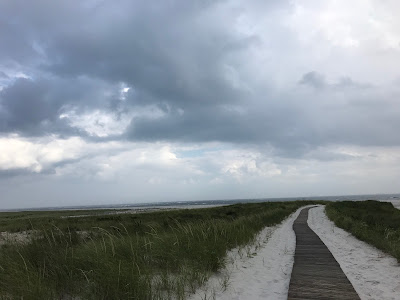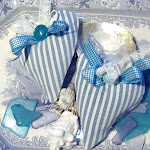Hi everyone!Post is very quilt-y, I put nice beach pics at the end for you all who are non-quilters.
April and May mean it's time to air and refold the quilts stored in the big white armoire. I started this annual project early and was making progress, but my visit to the eye surgeon again set off my recent extreme shoulder pain. I think it is from leaning awkwardly into those machines they use to examine one's eyes. So sadly I may not reach the bottom of the stack where some favorite summery quilts reside. I did manage to pull out this family quilt to share.
But first a fun miniature sewing room made by friends over the long winter. click to enlarge photos in this post
Isn't it adorable. Such detail.
The scale is so perfect, it almost looks like photos of a real life sewing room, I think. Sometimes I am inspired to do miniatures again. My dream was a lighthouse doll house with 19th century furnishings. Anyone here make miniatures/ room boxes/ dollhouses? lighthouse kit *note the size and price!
*************
Back to this family quilt I inherited. It is sadly faded and and very tattered, almost colorless [and very hard to photograph.]
I think it is beautiful and unique, though was maybe a kit, or newspaper pattern?
The quilt was made in the 1930s by a woman we referred to as an aunt, but she was not exactly that. My dad was very fond of her and was also interested in her beautiful quilts. He remembered this quilt always being on her bed. I knew her as a very old lady when I was a small girl. I loved to visit her to see her quilts, her spinning wheel, her endless Hummel children figurines, and her German Shepherd dogs. She had beautiful dinnerware, china, silverware, gold rimmed glasses with stems, as ladies of that era did have---and she was a terrible cook. My brother and I dreaded the food she served.
Aunt M was from Sheepshead Bay, Brooklyn, NY, an old 1600s Dutch* New York family--Van Something, Van Liewe?, she married a farm boy, or was he an insurance salesman? from Ohio and spent the rest of her life there in the Midwest.
This quilt's story is somewhat sad [if true]--- definitely second or third hand history, because no one wanted to ask about hurtful memories, I guess. Supposedly she made the top's center section as a young woman---teen? for her hope chest, as a crib quilt for her future children. She was not able to have children so she added the rest of the fabrics, turning it into a large full sized quilt on her own bed when she was a childless young married woman. She was soon widowed too, another reason she was included as ''family''. I hope to someday figure out how to get better photos of the center flowers and stems. Urns/ basket?
Best edge treatment ever! No binding, instead elegant knife edge with finely appliqued small scallops, interspersed with polka dots, tulips, and daisies.
The inner ''crib quilt" has a full scallops and flowers border also. All of course sewed with the tiniest invisible stitches.
Very thin cotton batting, white sheeting backing.
The quilting was done at her church quilting group. Lovely feathers, not-tiny but nice even stitches, about 8 or 9 stitches per inch
Sadly my aunt was a lifetime heavy smoker. By the time this quilt came to my parents it was so yellowe that the design was almost obscured. My mom always thought it was a Mountain Mist batting wrapper pattern or a kit; she called it Dogwood. We thought it was this quilt, images from Instagram.
This was possibly the original color, popular in the 1930s
At some point my mom decided to wash it because the odor was so bad, the quilt so grimy.. Imagine our surprise to find it's such a sweet folky tulips and scallops design instead. One I have never seen elsewhere. My mom was very good at washing antique quilts but her efforts to remove the reeking nicotine stains may have contributed to the already frayed and faded condition of this quilt.
We as quilters/ makers/ sewers often say we hope our quilts will be loved and used, but in a way I feel sad that this beautiful interesting quilt was ''loved to pieces'' instead of being valued and treasured. (I do have another of Aunt M's quilts, an appliquéd Magnolia Blossoms, that she said she made using a set aside Mountain Mist* kit, sewed on her lap during the frigid heat-rationed winters of WW 2 as she listened to the radio, praying for news of her loved ones.)
I think it is too fragile to be restored. I have no idea what its future holds, since heirlooms of this sort are not appreciated by the current generations. Not saleable or useable. No longer pretty enough to to fold for display [and you know I'll use just about any frayed old quilt if I think it is graphic or colorful!]
What would you do?
*Mountain Mist battings and patterns were produced in southern Ohio where this branch of my family lived. MM was their go-to supplier, possible cheaply bought at a factory outlet?
..................
Another find from the white cabinet, this sweet Sailboats top with signatures, c.1930-50. It was a Mother's Day gift from my son quite a few years ago now. He found it on eBay when he was a little guy teaching me how to post and sell on eBay. I had given him my PayPal [or he had set it up probably] to buy himself a golf club for his birthday; he also bought me this darling boyish quilt! I'm thinking of having it quilted this year.
.....................................
A fun mini quilt from TQC, a spring freebie. Just perfect for a phone rest. I may take a break from Marsh and make this cutie. Want to make it with me?
Back soon. Maybe we'll talk about books for a change of pace?
Mo caught on doorbell camera, while on sleepover earlier this week!
love
lizzy
gone to the beach...
*early settlers of New York were Dutch, truly Dutch. They created New Amsterdam, now New York, in the early 1600s. Not to be confused w ''Pennsylvania Dutch", another side of my family, who were actually German immigrants, not Dutch, who arrived later, 1700s-1800s.





















.JPG)




















.jpg)














